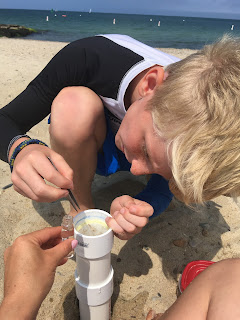This year we started to collect microorganisms using the plankton net we made for collecting micro-plastics. We collected all of our microorganisms samples at Menemsha Public Beach. I would wade into the water and drag the plankton net behind me. After I felt like a had enough samples in the net, I would swiftly lift it out of the water making sure nothing could escape while capturing the water in the bottle at the bottom. Then we would carry it up the beach and unscrew the cap above a Tupperware, releasing all of the water with plankton/seaweed into it. Sometime we would notice lots of organisms in our sample right away.
Other times, we would notice something tiny moving and realize we had found something really interesting. We took pictures of these organisms and then released them.
We found this organism.
We also found this crab, which looks like it recently left the megalopa stage.
Next we put some of the water through the PVC sieves we made. The sieves sorted the microorganisms by size.
We also just collected some of the water in vials to take home. After collecting all of the samples, we went home and started to look at them under a microscope. As soon as I stated to look, I noticed some interesting things. We took pictures of our slides, but we will need to do more research to figure what we are looking at.
I also saw lots of zooplankton swimming around but they were so quick, it was hard to focus on them with the microscope.
I saw a tiny creature that almost looked like a jellyfish, but we wonder if it really is because of how jellyfish develop. See below to learn more about the life cycle.
I need to do a lot more research to fully understand this though.
This is a video of the organism we observed.
We are not sure what species these organisms are, but we are excited to find out. If you happen to know or have any background information or any of the organisms we posted, we would love to hear from you.
We have purchased a few books that Suzan Bellincampi, the director of the Felix Neck Wildlife Sanctuary, recommended. We are going to do some researching this winter.
Can you guess what we'll be focusing on next summer in Martha’s Vineyard? I bet you can.









2 comments:
Grey,
I love that you have so many questions and that you have reached out to others to see if anyone can give you some leads. How exciting that you will be able to continue your research and learning during the school year, too. The way you include pictures and videos in the blog is really cool. I also like the way you found another use for the equipment you designed to find the microplastics.
Your horseshoe crab adventure was interesting to read, and it was overwhelming to imagine so many baby horseshoe crabs. Picturing Noah throwing them was funny too. (Amanda, he is so big now!!) I liked reading about how you shared your research with the scientists at the Woods Hole Institute and it is sure to inform their work and teaching. I look forward to seeing you soon!
Mrs. Arabia
What an interesting topic to study next! I liked your idea to use the sieves to sort the plankton by size. In school, students learn about "plankton" almost as if it's one type of organism - as in "Plankton is the second step of an ocean food chain," but that doesn't really capture the huge variety of organisms of different complexity and at different life cycle stages. Here are a couple suggestions as you move forward with this project - one, it might be helpful to learn more about the system that scientists use for the classification of living things. I'm sure you already know parts of the system, like fish, amphibians, reptiles, birds and mammals are all vertebrates, but you may not be as familiar with some of the other parts. Having that framework in your head will make learning about specific organisms easier to organize and remember. Second, you should see what microscope techniques and tips you can find - many of these organisms are sensitive to light, heat, and/or movement (as you observed!) so it can be tricky to view them. I can't wait to hear more about the project as it unfolds!
Miss Ostertag
Post a Comment